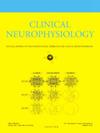Neural correlates of semantic and phonemic variants of verbal fluency tasks: A combined MEG and fMRI study
IF 3.7
3区 医学
Q1 CLINICAL NEUROLOGY
引用次数: 0
Abstract
Objective
The neural correlates of verbal fluency tasks (VFT) have been characterized by functional magnetic resonance imaging (fMRI). Still, the spatio-spectral neural oscillatory dynamics elicited by VFT and the differences between their semantic and phonologic variants are unsettled. We investigate, using fMRI and magnetoencephalography (MEG), the neural correlates of VFT and the differences in neural oscillatory dynamics between phonological (PFT) and semantic (SFT) fluency tasks.
Methods
Thirty right-handed healthy adults underwent MEG and fMRI recordings while performing covert PFT and SFT.
Results
fMRI showed different neural networks for PFT (left-dominant lexical-semantic control network) and SFT (nodes of the left-dominant semantic network). MEG showed beta-band power suppression in the left operculum in both VFT, with no difference between PFT and SFT.
Conclusions
MEG and fMRI detect distinct task-induced neural activity changes during VFT. MEG findings likely reflect the neural consequences of covert word production initiated at the inferior/middle frontal gyri, as identified by fMRI.
Significance
This study demonstrates the added value of combining MEG and fMRI to fully characterize VFT network dynamics. It paves the way for the use of VFT for non-invasive presurgical language mapping using a method free of neurovascular uncoupling.
语言流畅性任务的语义和音位变体的神经关联:脑磁图和功能磁共振成像的联合研究。
目的:利用功能磁共振成像(fMRI)研究语言流畅性任务的神经相关特征。然而,VFT引发的空间-频谱神经振荡动力学及其语义和语音变体之间的差异尚未解决。我们利用功能磁共振成像(fMRI)和脑磁图(MEG)研究了VFT的神经相关性,以及语音(PFT)和语义(SFT)流畅性任务之间神经振荡动力学的差异。方法:30名右撇子健康成人在进行隐蔽PFT和SFT时进行MEG和fMRI记录。结果:fMRI显示左优势语义控制网络(PFT)和左优势语义网络节点(SFT)的神经网络不同。两组VFT的脑磁图均显示左包膜β -波段功率抑制,PFT和SFT之间无差异。结论:脑磁图和功能磁共振成像检测到VFT期间明显的任务性神经活动变化。脑磁图的发现可能反映了由下/中额回启动的隐性单词生成的神经后果,正如功能性磁共振成像所识别的那样。意义:本研究证明了MEG与fMRI相结合对充分表征VFT网络动态的附加价值。它为使用无神经血管解耦的方法使用VFT进行无创术前语言映射铺平了道路。
本文章由计算机程序翻译,如有差异,请以英文原文为准。
求助全文
约1分钟内获得全文
求助全文
来源期刊

Clinical Neurophysiology
医学-临床神经学
CiteScore
8.70
自引率
6.40%
发文量
932
审稿时长
59 days
期刊介绍:
As of January 1999, The journal Electroencephalography and Clinical Neurophysiology, and its two sections Electromyography and Motor Control and Evoked Potentials have amalgamated to become this journal - Clinical Neurophysiology.
Clinical Neurophysiology is the official journal of the International Federation of Clinical Neurophysiology, the Brazilian Society of Clinical Neurophysiology, the Czech Society of Clinical Neurophysiology, the Italian Clinical Neurophysiology Society and the International Society of Intraoperative Neurophysiology.The journal is dedicated to fostering research and disseminating information on all aspects of both normal and abnormal functioning of the nervous system. The key aim of the publication is to disseminate scholarly reports on the pathophysiology underlying diseases of the central and peripheral nervous system of human patients. Clinical trials that use neurophysiological measures to document change are encouraged, as are manuscripts reporting data on integrated neuroimaging of central nervous function including, but not limited to, functional MRI, MEG, EEG, PET and other neuroimaging modalities.
 求助内容:
求助内容: 应助结果提醒方式:
应助结果提醒方式:


